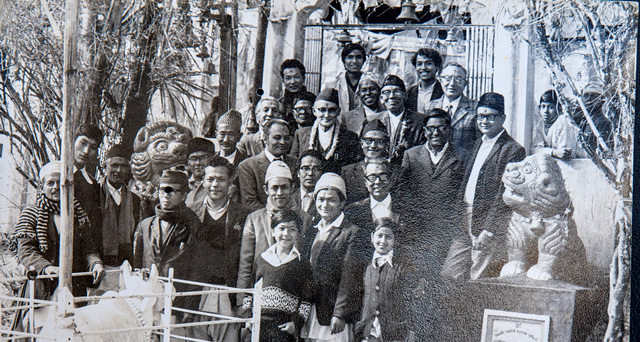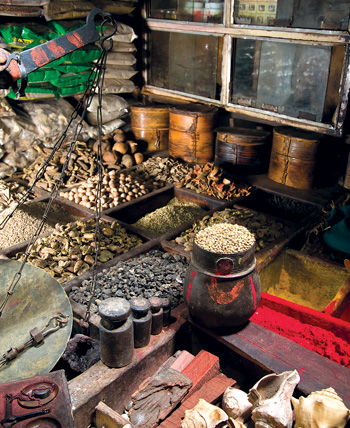The Enterprising Newar Traders of Nepal

The young Bhim Shakya was a frustrated young man. He had returned after a lengthy sojourn to foreign lands where he had gone looking for work, and now back in Nepal, had to settle on the role of a teacher at the Cottage Industries Department for a meager three rupees per day. Neither the work, nor the pay, were to his liking. He was a skilled chiseler, and yet couldn’t earn a decent living doing what he loved to do, that is, chisel out remarkable designs on metal figures.
Ever since he was an 11-year-old, he had been helping out his father in their jewelry making business in Oku Bahal of Lalitpur, but with rise in gold prices and the subsequent fall in business, at 15, he had left for Lhasa, where he lived and worked for eight years. He then became a monk in a gumba (monastery) there so as to get an education. He returned home to Nepal in his early 20s, and still unable to find suitable work, went to Darjeeling, Kalimpong, and Sikkim in search of the same. Now, back home again after five years, he had found work, but one that did not satisfy him in the least.
 Then, Lady Luck decided to bless this struggling but skilled chiseler with her favor. It came in the form of a gentleman by the name of Mr. Bhim Raj Sthapit, popularly known in the business community as Kancha Sahu (Kancha: youngest; Sahu: merchant). Now, this enterprising Sahu had been a successful trader for quite some time, dealing in all types of goods, and open to any new ideas for furthering business opportunities. On meeting him, Bhim Shakya put forward his opinion that if there was some way that copper could be used to make metal figures (at that time only bronze and brass were being used), significantly superior work could be produced that would command a bigger and more lucrative market.
Then, Lady Luck decided to bless this struggling but skilled chiseler with her favor. It came in the form of a gentleman by the name of Mr. Bhim Raj Sthapit, popularly known in the business community as Kancha Sahu (Kancha: youngest; Sahu: merchant). Now, this enterprising Sahu had been a successful trader for quite some time, dealing in all types of goods, and open to any new ideas for furthering business opportunities. On meeting him, Bhim Shakya put forward his opinion that if there was some way that copper could be used to make metal figures (at that time only bronze and brass were being used), significantly superior work could be produced that would command a bigger and more lucrative market.
Copper, he said, was more malleable, and convivial to finer chiseling work, as well as to painting. But, copper needed very high heat to be melted, and since coal was not freely available at that time in the valley, nobody had yet started working with this metal. Bhim Shakya assured Kancha Sahu that he could arrange for a regular supply of coal. Then, in his own words, “The two of us went all around Patan, door to door, to find craftsmen willing to make the statues. In the end, it was a very fruitful endeavor. I ended up making 10 times what I was getting in my old job!” Not only were his statues sold within the country, but also in places as far as Hong Kong. With a lot of help from Kancha Sahu, of course.
Kancha Sahu exemplifies the shrewd business acumen of the Newar traders of Kathmandu Valley, who have, and still are, playing such an important role in ensuring that the beautiful art and craft of our highly skilled artists and artisans reach markets far and wide, and that they receive the due reward such artistry so richly deserves. Kancha Sahu is but one example of many. Till a few decades ago, one could hear the names of many such ‘Sahus’ bandied about quite a lot.
For instance, ‘Ghyo Sahu’ (merchant of clarified butter), ‘Tel Sahu’ (oil merchant), ‘Chakku Sahu’ (molass merchant), and so on. One Sahu, credited with being the first spice merchant of Nepal, started his business by importing conches from the shores of Kerala, and seeing the bursting flavorful cardamoms of that region, later began bringing in a wide variety of spices, as well. His shop, once famously known as ‘Shankha Pasal’ (Conch Shop), is still there in the historical Asan Bazaar of the capital, selling both conches and spices.
One famous name, especially recalled during the wedding season, was ‘Lal Sahu’ (red merchant). Now, he didn’t deal in communism, he dealt in that most fundamental of garments worn by Nepali ladies, that is, saris, and during the season, his shop would be practically the only place to go for a glittering wedding sari. His shop is still there in Indrachowk, and it is still popular, but you should have seen the crowds back then, when there were hardly any other sari shops of repute in the valley!
Besides these, another particular area that Newar traders were experts in, was in doing business with Tibet. One name that immediately comes to mind is that of Bahjuratna Kansakar, the esteemed patriarch of the Jyoti family, today one of the country’s leading business families. He was the epitome of the adventurous Newar traders of Kathmandu Valley. At a time when there were no roads to speak of linking Nepal to the outside world, let alone, Kathmandu Valley, one cannot but admire such traders’ grit and determination to dare to explore hereto unseen foreign lands to seek their fortune.
My own great grandfather (maternal) went to seek his fortune in Darjeeling, India, where he opened a curio shop that was full of art and craft work from Kathmandu, as well as from different parts of India. It was during his son’s time that, with the ending of World War II, Darjeeling was inundated by swarms of British soldiers, all of whom wanted to buy the khukuri made famous by the Gurkhas, those brave soldiers whose exploits were legendary during the war. So, the enterprising man that he was, as are most Newar traders, my grandfather brought in plenty of khukuris from eastern Nepal. He is somewhat of a legendary figure himself, even today the story goes that he himself carried hundreds of khukuris in a doko (woven bamboo basket) on his back to his shop, Nepal Curio House, near Chowrasta of Darjeeling.
The shop is still there, and during and after the Chinese takeover of Tibet, many Tibetans, mostly Khampas (a daring Tibetan clan), used to come there to sell statues of Tibetan deities, thangkas (religious scroll paintings), and the like. After a bit of chit-chat, the Tibetan seller would dig into his voluminous dress and bring out a statue, or another object, some of which would be blackened by age, and show it to my grandfather. More often than not, my grandfather would treat the object with some disdain, and name a very low price. The sellers were, of course, no match for my grandfather’s, the shrewd Newar trader’s, bargaining skills, and usually settled for a price that would be pretty low.
I’ve also heard a story that, in those days, many such statues were pinched from monasteries, and often had gold inside their sealed bottoms. I never could verify this, so can’t say how true it is. Anyway, as mentioned before, my grandfather also sold a lot of art and craft work from Kathmandu. People like the aforesaid Kancha Sahu, most probably, were from whom he bought valuable pieces of work, mainly deity figures and silver work. Darjeeling, being a tourist town, had no dearth of customers, especially during the ‘season’, when the picturesque hill station was awash with tourists from all over the world, as well as from all over India. By the way, some of the objects bought at very low prices, turned out to be real antiques that fetched hefty profits, even though they might not have been so recognized by the sellers themselves. My grandfather, the astute Newar trader, certainly did!
Today, there are plenty of ‘Sahus’ in Nepal, and they deal in a large variety of products. Many of the traders are into importing foreign goods, which have a large market in the country. At the same time, there are many traders who are into the export of Nepal’s art and handicraft. There are also many producers, headed by skilled artists and craftspeople themselves, who are approached directly by customers from abroad to place their orders. In recent times, most such buyers are from China, where there is increasing demand for Nepali art and craft. The more reputed producers have orders that keep them busy throughout the year. Well, all said and done, the days of the legendary ‘Sahus’ may be over, but their daring and entrepreneurial feats continue to inspire many more Newar traders today.











